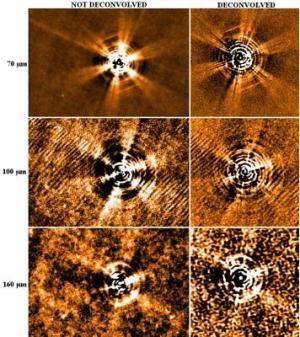An international team led by KU Leuven astronomer Leen Decin discovered not less than a dozen cold dust arcs around the giant star CW Leo. The team used the sensitive PACS instrument on board the Herschel Space Observatory to detect for the first time arcs of dust far away from the star. CW Leo has expelled these shells of dust in different epochs in its life. The faintest shell we can see now was, according to the team, expelled about 16,000 years ago. In the mean time it has drifted away from the star over more than 7,000 billion kilometers.
 "Until recently, the environment of giant stars seemed homogeneous, but more and more observations indicate that this is not true," says Leen Decin. "These new Herschel images confirm that in a stunning way. We have detected a dozen arcs, puffed out by the star in the course of its life. The faintest shell we found is already at a distance of 7,000 billion kilometers from the star."
"Until recently, the environment of giant stars seemed homogeneous, but more and more observations indicate that this is not true," says Leen Decin. "These new Herschel images confirm that in a stunning way. We have detected a dozen arcs, puffed out by the star in the course of its life. The faintest shell we found is already at a distance of 7,000 billion kilometers from the star."
The Astronomical Research Center (A.R.C) mentioned that The different shells were ejected by the star with intervals of 500 to 1,700 years. The astronomers in the team believe such shells, even fainter, are also present further out, up to the violent bow shock where the expelled material of the star collides with the interstellar medium. The oldest shells have probably disappeared in the bow shock already.
Our own Sun too will turn into a red giant star, about five billion years from now, when it will inflate and condensate dust in the outer, cooling layers of its atmosphere. The episodes in CW Leo's history help astronomers understand the future of our own Sun.
Since the different shells have been travelling far away from the star by now, they are also very cold, about -248°C. The PACS instrument onboard the Herschel Space Telescope was especially designed to make images of the far-infrared light emitted by dust that cold. Thanks to the Belgian participation in the building of the PACS instrument, the team got priority access to the space telescope. Christoffel Waelkens, Co-principal investigator of the PACS instrument consortium is proud of yet another discovery by Herschel: "We had a lot of ideas for science with Herschel, but we also hoped that Herschel would surprise us with unexpected results. It has been a continuous delight since the first observations: at every opportunity nature proves to have more imagination than we have, but still presents us the phenomena so that we can understand them."
Making the rings visible in the Herschel images was not trivial. Pierre Royer, instrument expert in the PACS team of the Institute of Astronomy at KU Leuven, clarifies: "The work of constantly refining the instrumental calibration and improving the data-analysis techniques really becomes rewarding when it comes to push the instrument to its limits, allowing for cutting-edge science." Also after the Herschel Launch in 2009 the PACS instrument team, including 7 scientists and engineers at KU Leuven, continued to refine the initial calibration and data analysis software.